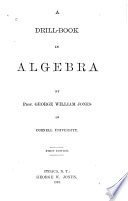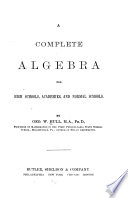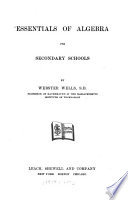 Divide the first term of the remainder by three times the square of the root already found, and write the quotient for the next term of the root. Divide the first term of the remainder by three times the square of the root already found, and write the quotient for the next term of the root.  The Elements of Algebra - Page 100by George W. Lilley - 1892 - 402 pagesFull view The Elements of Algebra - Page 100by George W. Lilley - 1892 - 402 pagesFull view - About this book
 | George William Jones - Algebra - 1892 - 300 pages
...perfect cube first; take the cube root of the first term of the polynomial as the first term of the root; divide the first term of the remainder by three times the square of the root found, and make the quotient the next term of the root; to the divisor add three times the product... | |
 | George P. Lilley - Algebra - 1894 - 522 pages
...term. This will be the first term of the required root. Subtract its cube from the given expression. Divide the first term of the remainder by three times the square of the root already found. The quotient will be the next term of the root. Add to the trial divisor three times the product of... | |
 | William James Milne - Algebra - 1894 - 214 pages
...term, write the result as the first term of the root, and subtract its cube from the given polynomial. Divide the first term of the remainder by three times the square of the root already found, as a trial divisor, and the quotient will be the next term of the root. Add to this trial divisor three... | |
 | William James Milne - Algebra - 1894 - 216 pages
...term, write the result as the first term of the root, and subtract Us cube from the given polynomial. Divide the first term of the remainder by three times the square of the root already found, as a trial divisor, and the quotient will be the next term of the root. Add to this trial divisor three... | |
 | William James Milne - Algebra - 1894 - 212 pages
...term, write the result as the first term of the root, and subtract its cube from the given polynomial. Divide the first term of the remainder by three times the square nf the root already found, as a trial divisor, and the quotient will be the next term of the root.... | |
 | George Washington Hull - Algebra - 1895 - 358 pages
...first term, write the result as the first term of the root, and subtract its cube from the polynomial. Divide the first term of the remainder by three times the square of the root already found, and write the quotient for the next term of the root. Add to the trial divisor three times the product... | |
 | Henry Sinclair Hall, Samuel Ratcliffe Knight - Algebra - 1895 - 212 pages
...б2) х 6. Now the first term of the remainder is the product of 3а2 and b. Т1иф to obtain 6 we divide the first term of the remainder by three times the square of the term already found. Having found b we can complete the divisor, which consists of the following three... | |
 | George Washington Hull - Arithmetic - 1895 - 408 pages
...second term of the root, and subtract the product from the remainder. If other periods remain, take three times the square of the root already found for the next trial divisor, and proceed as before. When a cipher occurs in the root, annex two ciphers to the trial... | |
 | Webster Wells - Algebra - 1897 - 422 pages
...the given expression; arranging the remainder in the same order of powers as the given expression. Divide the first term of the remainder by three times the square of the first term of the root, and write the result as the next term of the root. Add to the trial-divisor... | |
 | Webster Wells - Algebra - 1897 - 384 pages
...from the given egression; arranging the remainder in the same order of powers as the given expression. Divide the first term of the remainder by three times the square of the first term of the root, and write the result as the next term of the root. Add to the trial-divisor... | |
| |